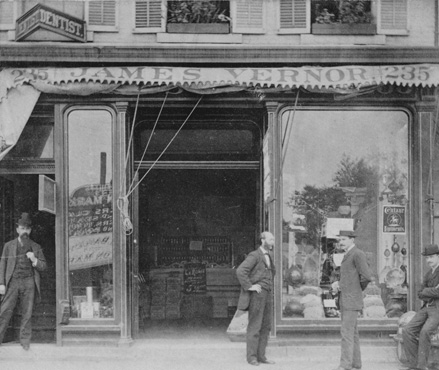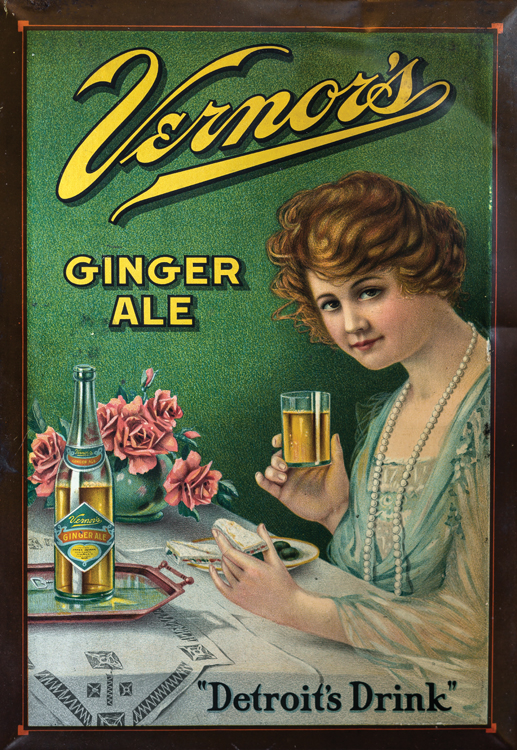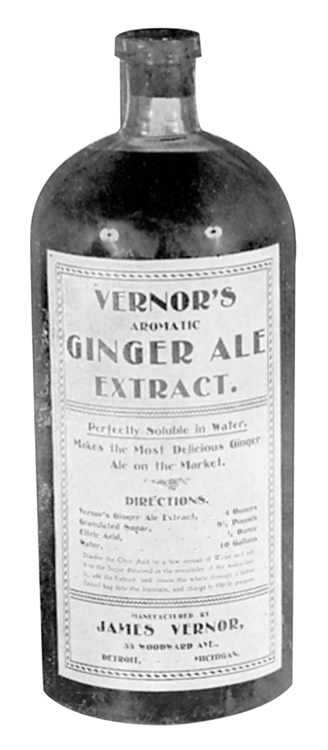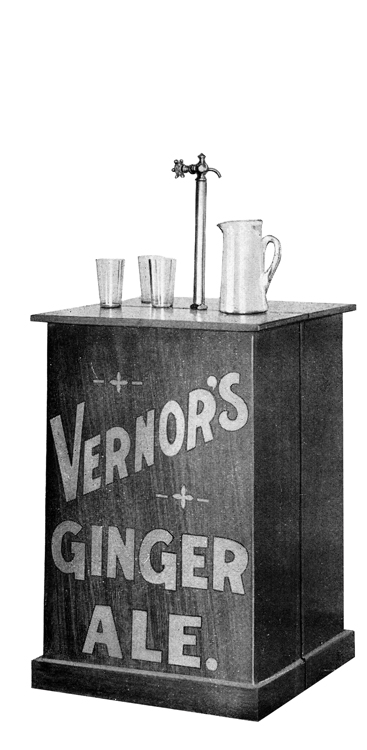
When it comes to soda pop, nobody loves Vernors like we do.
The “deliciously different” ginger ale — highly carbonated, with a potent ginger kick — is likely an acquired taste, enjoying a cult following in its birthplace of Michigan. Its signature green and gold packaging (and winking gnome mascot) are an ubiquitous sight from vending machines to holiday parties, and the devoted will even swear by its healing properties: Can you really be a true Michiganian if you haven’t used Vernors to nurse a sore throat, stomachache, or hangover?

It’s that cult following that has helped keep Vernors alive for 150 years, making it the oldest continuously manufactured soft drink in the United States.
Just ask Keith Wunderlich. A superintendent for Waterford Public Schools by day, Wunderlich spends his free time serving as Vernors’ unofficial historian as part of the Vernor’s Ginger Ale Collectors Club. The Troy resident has spent the past 35 years collecting all manner of Vernors artifacts and ephemera, transforming his basement into a veritable shrine to the golden beverage.
“At some point along the way I went crazy, yeah,” Wunderlich says with a laugh. He says he started collecting Detroit antiques, but began focusing on Vernors after stumbling upon a large stash of vintage glass bottles from his parents’ garage. Now his collection includes Vernors advertisements, vending machines, neon signs, toys, clocks, and even a large mechanical gnome. The centerpiece of the collection is undoubtedly the functional retro soda fountain salvaged from an ice cream parlor.
Rummaging through Wunderlich’s unofficial museum, it’s easy to see how Vernors is part of Detroit’s DNA — thanks, in part, to provincial marketing schemes featuring slogans like “Detroit’s drink” and “It’s what we drink around here.”
Birth of a Legend
Like a good cult, Vernors even has its own creation myth. The ginger ale was invented by one James Vernor, a young errand boy working at Detroit’s Higby and Stearns drugstore. As legend has it, a teenage Vernor was experimenting with mixing ingredients in an oak barrel just before the Civil War broke out. He soon enlisted, serving in the Fourth Michigan Cavalry, and at the war’s end he returned home to start his own pharmacy located at 235 Woodward Ave. That’s when he opened the forgotten barrel and found that four years of aging had produced a ginger ale that was “deliciously different,” as it would soon be dubbed.
Today, the story is proudly repeated on the Vernors corporate website, though historians have cast doubt on whether it is fact or fiction. A July 29, 1936, Detroit News article about the 70th anniversary of the company doesn’t even mention the myth. Instead, Vernor’s son James Vernor II told the reporter that his father didn’t start making the ginger ale until after he returned from the war, saying “I suspect that all through the war he carried in his mind that formula for the soft drink.” A June 11, 1962, Detroit News story acknowledges the myth, but dismisses it as “fascinating, even if inaccurate.”

Regardless of exactly how and when he arrived at his formula, Vernor started selling his ginger ale at his pharmacy’s soda fountain by 1866. It would be just one of several successful ventures Vernor would enjoy after the war.
In 1888, Vernor decided to enter politics. He was elected to be an alderman in Detroit, an early version of city council. His role in the passage of sewerage laws would help Detroit become a business hub. And noticing that some pharmacist competitors were selling medicine whose effects were unproven or even worse, harmful, Vernor helped establish industry regulations by forming the Michigan Board of Pharmacy. He would operate his business under the board’s first license.
“The guy was nonstop. Everything he did, he did 1,000 percent,” Wunderlich says. “Everything he touched, he turned to gold.”
Meanwhile, Vernor’s side hustle took off. By 1896 he closed his pharmacy, and his son joined him to focus on bottling and selling Vernor’s Ginger Ale (note the apostrophe). He purchased the Riverside Power Plant at the foot of Woodward, converting it into an innovative 10-story bottling plant that used gravity to move the bottles along on rollers from one floor to the next. His background as a pharmacist helped him establish state-of-the-art methods for purifying the factory’s water, and he began producing extracts so franchises could bottle and sell Vernors across the country.
Gnome-town Advantage
Vernors grew as Detroit grew, and the riverfront site would soon become one of the city’s most iconic landmarks. An enormous Vernors sign was a main fixture of the skyline. Operations expanded into an entire city block, including an opulent on-site marble soda fountain, a favorite stop for passengers boarding the ferry to the Bob-Lo amusement park. Each summer, the company celebrated its anniversary by offering thousands of free glasses of Vernors, or Boston Coolers, the local favorite made from blending Vernors and vanilla ice cream.
Yet despite the company’s good standing with Detroit, Vernor’s business occasionally became a conflict of interest for his political career—such as when he killed a plan to construct a subway underneath Woodward when he found out the station would be built in front of his store.
Vernor died in 1927 at 84, but the family business continued. Eventually, the city approached the company to acquire the land to redevelop the riverfront, which would include the creation of Cobo Hall. In exchange, the city offered the location of its previous convention center at 4501 Woodward Ave., near the Whitney mansion.
The iconic factory was razed, but the company took the opportunity to build a sleek, modern facility that would continue to be a highly visible part of Detroit’s identity. The new plant opened in 1954, complete with a 55-foot, 75,000-watt sign depicting a gnome pouring a bottle of ginger ale. All along Woodward Avenue, large glass windows allowed passersby to take a peek at the manufacturing process, and the facility offered tours (that’s where Wunderlich’s mechanical gnome came from).
Losing Some Fizz
It was at this time that the company’s fortune would start to turn, however. Shortly before the new factory opened, James Vernor II died at 77, leaving behind unsettled taxes. The family’s finances were further complicated by the death of James Vernor III, who died from cirrhosis in 1957 at 39. By the company’s 100th anniversary, the family decided to go public, selling off its stock to a group of New York-based investors.
Eventually, under the ownership of Cincinnati-based United Brands, Detroit’s Vernor’s factory was unceremoniously shuttered in 1985. The location is now the site of luxury apartments.

But Vernors didn’t die. The brand changed ownership several times before entering the portfolio of its current owners, the Plano, Texas-based Dr Pepper Snapple Group. It’s unlikely, however, that the ginger ale’s spiritual successor has much in common with James Vernor’s original concoction.
For almost its entire history, Vernors advertising and packaging claimed it was barrel-aged for four years. The claim was finally dropped under Dr Pepper’s ownership in the mid-’90s. As recently as 2013 a badge on the packaging claimed a “Barrel Aged Bold Taste.” Today, Vernors bottles and cans use a wooden barrel design motif. The badge shows an illustration of a barrel accompanied by the words “Authentic Bold Taste” — probably as close as a corporation can come to perpetuating James Vernor’s claim without actually doing so. (Who knows if Vernors ever even used oak barrels to brew its ginger ale? The precise recipe was reportedly a closely guarded family secret, unknown even to those who worked at the company.)
Up until recently, Vernors was still bottled in Detroit through an arrangement with Pepsi. Today, it’s bottled on the west side of the state in a facility in Holland, using concentrates made in St. Louis.
Despite the fact that Vernors is no longer made in Detroit, Michigan’s love for the drink continues as fervently as ever.
“For us in the state of Michigan, it’s our No. 1 brand,” says Arend Scott, the Dr Pepper Snapple Group’s Michigan director of regional accounts. He says the brand is one of the company’s most consistent selling from year to year. As a state, Scott says we guzzle more than 7 million cases of Vernors annually, and in the Detroit and Flint markets Vernors is outsold only by the soft drink giants Coca-Cola, Pepsi, and Mountain Dew.
A 150th Anniversary Toast

Nationally, Vernors may not be one of the company’s biggest brands, whose portfolio also includes 7-Up, A&W Root Beer, and Sunkist, but Scott says the company is treating Vernors’ 150th anniversary like the launch of a new product. This summer, new packaging will feature a 150th anniversary logo. Scott says to also look out for in-store displays touting the brand’s Michigan ties as well as billboards, including Cobo Center’s digital marquee.
“You don’t celebrate 150 anniversaries of too many things in this industry,” Scott says. “It’s an exciting thing for us.”
In fact, the company is working with Wunderlich and the Vernor’s Ginger Ale Collectors Club to plan a week of festivities in celebration of the milestone. Wunderlich has helped organize a “Vernor’s Week” celebration starting on June 5, which will see local restaurants incorporate Vernors in unique menu items (look for them at spots including Republic, Parks and Rec, Cass Cafe, Huron Room, Iridescence, Broderick Grille, Mudgie’s, Union Street, Batch Brewing, Mercury Burger Bar, La Feria Spanish Tapas, The Block, Ottava Via, Chartreuse, and others). And throughout the city, buildings with historical ties to Vernors will be lit up green and gold.
It all culminates in a Vernors Day celebration on June 11 at the Detroit Historical Museum, harking back to the traditional summertime anniversary parties thrown in Detroit back when Vernors was a family-owned company. All proceeds will go toward raising the $5,000 necessary to erect a historical marker to commemorate the brand’s Detroit ties, likely to be placed at one of the company’s three locations along Woodward Avenue.
Wunderlich says to expect a history presentation, a photographic scavenger hunt, and plenty of Boston Coolers to go along with the day’s activities. James Vernor’s great-great grandson and great-great-great grandson—James Vernor V and VI—are slated to make an appearance. Wunderlich is even trying to coordinate a world record for most people drinking Vernors at once.
We’ll raise a glass to that.
How Vernors became a Detroit favorite
» 1843 James Vernor is born in Albany, N.Y. His family moves to Detroit in 1848.

» 1852 Ginger ale is developed in Ireland.
» 1858 Vernor takes a job as an errand boy at Higby and Stearns drugstore.
» 1861 U.S. Civil War starts.
» 1862 Vernor joins the Fourth Michigan Cavalry.
» 1865 The Civil War ends.
» 1866 Vernor opens Vernor’s Pharmacy at 235 Woodward Ave., where he starts selling his ginger ale.
» 1877 James Vernor II is born.
» 1888 James Vernor is elected as a Detroit city alderman.
» 1896 Vernor closes his drugstore, and he and his 19-year-old son enter business together. They open a new store at 33 Woodward Ave., south of Jefferson Avenue (later renamed 239).
» 1918 Vernor purchases Riverside Power Plant at the foot of Woodward and converts it into a bottling plant.

» 1920 Around this time, the Vernors gnome first appears in advertising.
» 1927 James Vernor dies at 84. James Vernor II becomes president.
» 1931 James Vernor Davis, grandson of James Vernor I, joins the company.
» 1936 Vernor’s ginger ale turns 70. The company gives away 100,000 glasses of Vernors, starting a tradition of celebrations that would last into the 1960s.
» 1941 Vernor’s expands into nearby 10-story Siegal building, dubbed the “Most Modern Bottling Facility in the World.”
» 1951 The city of Detroit asks Vernor’s to move to make way for civic center. The company moves to the site of the city’s former convention center at 4501 Woodward Ave. near Wayne State University.
» 1952 James Vernor Davis becomes president.
» 1954 James Vernor II dies. The new plant opens at 4501 Woodward Ave.
» 1957 James Vernor III dies at 39 from cirrhosis.

» 1959 The company name changes from Vernor’s to Vernors (no apostrophe).
» 1966 As Vernors turns 100, it is sold to a group of investors for $4.5 million.
» 1971 Company is sold to American Consumer Products.
» 1979 Cincinnati-based United Brands acquires the company.
» 1985 The Detroit plant abruptly closes.
» 1987 A&W Brands acquires the company for $11 million. The company introduces a new product called Vernors California Natural, a fruit-flavored offshoot that is a commercial failure.
» 1993 Cadbury Schweppes buys A&W Brands.
» 1994 Cadbury Schweppes acquires Dr Pepper, placing Vernors under the provision of Dr Pepper.
» 2016 Vernors celebrates its 150th anniversary, making it the oldest continuously manufactured soft drink in the U.S.
Special Thanks: Much of the early history of Vernors is adapted from The Vernor’s Story by Lawrence L. Rouch and Vernor’s Ginger Ale by Keith Wunderlich.
|
|
|









